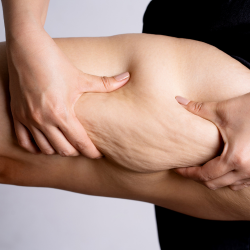Introduction: Liposuction For Lipedema
Lipedema is a condition that causes abnormal, disproportionate fat growth in the hips, thighs, and legs. The fatty tissue is painful, and tender, and easily develops bruises. If you have lipedema, you may wonder if liposuction could help. Research shows properly performed liposuction can provide significant improvements in pain, mobility, and appearance for lipedema patients.
What is Lipedema?
Lipedema causes excessive symmetrical fat accumulation from the hips down to the ankles (Fife et al., 2010). The abnormal fat deposits tend to be painful to the touch. Lipedema occurs almost exclusively in women and is thought to be aggravated by hormonal changes.
Common symptoms include (https://my.clevelandclinic.org/health/diseases/17175-lipedema):
- Disproportionate fat growth in the legs, hips, and buttocks
- Bruising easily from minor bumps
- Tenderness, pain, and swelling in the tissue
- Feet and hands spared from fat growth
- Little to no improvement with diet and exercise
While the root causes of lipedema remain unclear, treatments aim to minimize discomfort, improve mobility, and restore proportion.

How Can Liposuction Help Treat Lipedema?
Several studies have found liposuction to be an effective treatment approach for lipedema (Dadras et al., 2017). During the procedure, a plastic surgeon uses small cannulas to suction out the abnormal fat deposits. Common sites for fat removal include:
- Hips
- Outer and inner thighs
- Lower legs
- Knees
Compared to non-surgical treatments, liposuction provides a more significant reduction of fatty tissue and related pain. Research shows most patients experience long-term improvements in pain levels and ability to perform daily activities after liposuction (Dadras et al., 2017). Clothing also fits better due to the body contouring effects.
Who Are the Best Candidates for Lipedema Liposuction?
Ideal candidates for liposuction for lipedema include (Wollina et al., 2019:
- Women with a formal diagnosis of lipedema from imaging and lab work
- Those who experience significant pain, swelling, and bruising from lipedema
- Patients troubled by impaired mobility or gait issues from enlarged lower body
- Women at or near their ideal weight aside from lipidomic fat
- Individuals with good skin tone and elasticity
- Non-smokers with well-controlled medical conditions
A thorough pre-operative exam determines if you meet the criteria.
What Can I Expect During Recovery After Liposuction for Lipedema?
Recovery usually requires:
- Wearing compression garments for 4-6 weeks post-op (Bahcebasi et al., 2022)
- Limiting activity for the first week
- Keeping incision sites clean while healing
- Avoiding rigorous exercise for 2-3 weeks
- Managing mild bruising, swelling, and discomfort
- Most return to normal activities within 1-2 weeks (https://my.clevelandclinic.org/health/diseases/17175-lipedema)
Follow all instructions provided by your plastic surgeon for optimal healing.
What Results Can I Expect from Liposuction for Lipedema?
Many patients report significant improvements such as (Schmeller et al., 2012):
- Up to a 90% reduction in pain symptoms
- Decreased hypersensitivity to touch
- Resolution of hematomas and bruising
- Improved ability to perform daily tasks
- Better fitting clothes
- Smoother body contours in treated areas
- High satisfaction with improved appearance
However, lipedema fat may gradually return over the years. Periodic maintenance liposuction helps sustain results.
Treatment Alternatives to Liposuction for Lipedema
Ultrasound-assisted liposuction for lipedema has proven to be the most effective treatment. Lipedema is characterized by an uncontrollable growth of fat cells mostly in women. It has been characterized by symmetric enlargement of the legs as fat cells grow uncontrollably when compared to normal fat cell growth. Although these fat cells are not malignant, their growth is dramatic and results in swelling of the legs extending from the hips down to the ankles. A staggering 10% of women have been identified to suffer from lipedema. Several non-invasive treatments have been recommended and these include compression garments, pneumatic boots, manual lymphatic massages, and exercise.
Unfortunately, these measures have only had minimal success. Even though weight loss with aggressive exercise may prove to be most effective, the physical act of exercise is often prohibitive by the humbling fact that the bulk in between the legs prohibits running. Patients with lipedema may experience physical limitations and subsequently mental anguish extending from their physical incapacity. The sheer inability to fit into regular clothes can have psychological repercussions.
Ultrasound-assisted Liposuction for Lipedema
Recent advances in liposuction using ultrasound-assisted liposuction have made liposuction for lipedema a real treatment alternative. Ultrasound-assisted liposuction can deliver energy that frees up the fat cells from each other and more importantly nerves and vessels such as the veins, arteries, and lymphatic channels. Why this is important is that ultimately leg swelling is what incapacitates these patients.
As such, any surgical measure that attempts to remove the fat cannot injure the vascular structures which will cause further swelling and leakage of plasma fluid from the vessels. Ultrasound-assisted liposuction is the Gold standard in being able to liquefy and release the fat cells from each other and neighboring structures so that they can be gently removed. Removal of fat cells has proven to be the definitive treatment for lipedema. If you have been suffering from lipedema and have not had any luck with conservative measures, we urge you to contact one of our high-definition liposuction providers so that we can offer you the first effective treatment of high-definition liposuction for your lipedema.
Conclusion: The Role of Liposuction for Lipedema Management
For patients struggling with lipedema, liposuction performed by an experienced surgeon can safely and effectively address concerns. Removing disproportionate fat deposits significantly reduces tenderness, bruising, and mobility issues to improve quality of life. While not a cure, liposuction has proven benefits for managing symptoms and restoring body proportions affected by lipedema. Discuss your candidacy with a board-certified cosmetic or plastic surgeon.

